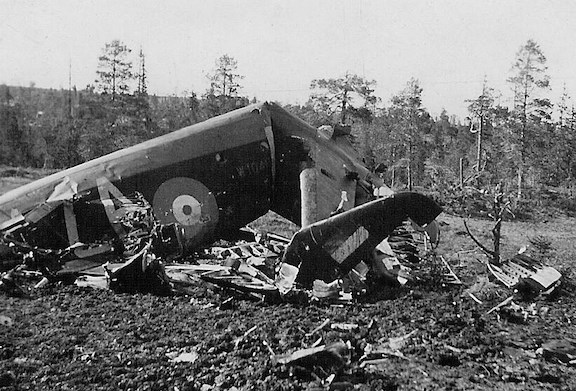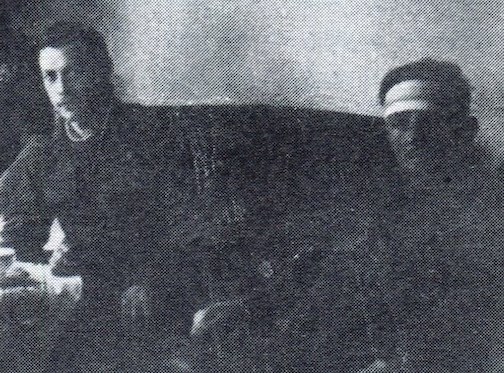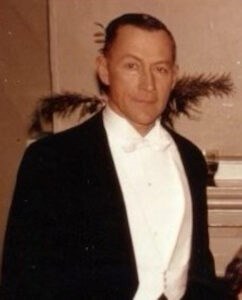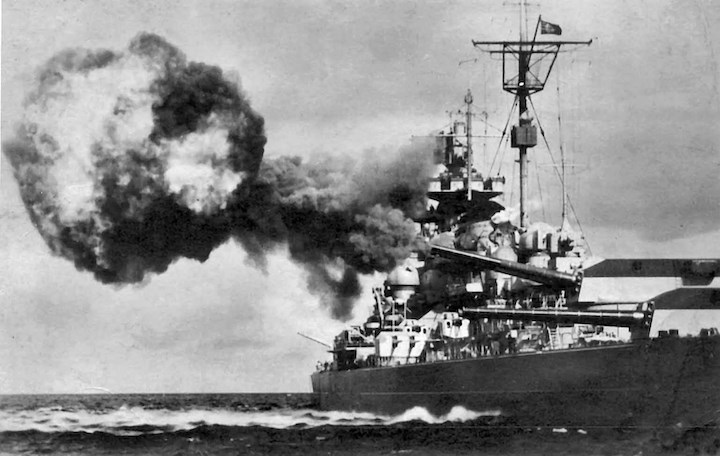As part of our Sarnia Remembers series — now in its eighth year — The Journal is publishing a series of stories this week, honouring veterans and fallen soldiers from Sarnia-Lambton.
By Tom St. Amand and Tom Slater
Continued from Part 1.
It was nearing midnight on April 27, 1942.
Sixty-five kilometres west of the Tirpitz, airmen from RAF 10 and 35 Squadrons readied themselves for phase two, with Bunt Murray's Halifax W1041 leading the way.
Their assignment was not for the faint of heart.
Each of the seven bombers held four 1000-pound spherical bombs dubbed “roly-polies.” Containing over 770 pounds of Amatol, a “roly-poly” was a recently developed contact mine that was designed to sink below the water before detonating. Water pressure would activate the mine’s hydrostatic pistol and cause the device to detonate.
To make this possible, a pilot would have to level his bomber to a perilous height of 150 feet on his approach. Each Halifax was expected to drop her “roly-polies” between the ship and the shore at 100 and 200 foot intervals. The crews had been assured that the mines would roll down the steep mountain surface which sloped beneath the base of the ship. If delivered accurately and set to go off at the right depth, the mines would rip a giant hole in what was supposed to be Tirpitz’s most vulnerable point—her bottom. In typical understatement, the laconic Bennett had let Bunt and his crew mates know that their mission was going to be “a little difficult.”
No one aboard the lead Halifax anticipated that the enemy would find them so early. Fifty kilometres from the Tirpitz, an 88-millimetre shell from a shore battery struck the bomber—a “lucky hit” as Bunt called it. A small fire crackled in the aircraft, but by the time Bennett had started his harrowing descent as he approached Trondheim, his Halifax was in flames and advertising her position to German gunners. Flying this low, the crew took heavy AA fire not only from below the aircraft, but also from the AA batteries on the cliffs above the fjord.
Undaunted, Bennett lowered his Halifax into position as enemy fire continued to erupt all around him.
Bunt recalled that “all hell broke loose… it was an inferno. The fuselage was torn apart and the engine was on fire and spreading.”
From his vantage point, Bunt knew they were close to the inlet berthing Tirpitz, but all the crew could see were Tirpitz's masts and flashes of enemy fire coming through the dense smoke covering the inlet. They did not have a chance to release the mines, so despite the flames engulfing the Halifax and despite taking flak from both sides of the fjord and from Tirpitz's guns, Bennett circled again for a second attempt. The situation, however, remained hopeless, and Bennett again could not release the four mines on board.
The crew of Halifax W1041 had one chance to survive. When Bennett climbed above Faettenfjord, flak from a nearby battery hit the wing and fire broke out behind the starboard inner engine. Completely composed, Bennett continued flying east, gained some altitude, and jettisoned the “roly-polies”. When the starboard inner engine cut out and the starboard wheel fell down into the landing position, the bomber became very unstable. At this point, Bennett ordered his crew to bail out of the burning bomber.
Miraculously, all seven airmen parachuted to safety before the bomber disintegrated in mid-air and crashed. Bunt was the third man out—he remembered pulling his ripcord, swinging twice, and landing in a tree. Somehow, he managed to get to the ground with no injuries and, shortly after, Bunt met the tail gunner, George “Mick” How, who had been stuck in a nearby fir tree before freeing himself. Mick was in rougher shape. He had broken ribs, an injured knee, a cut forehead and, when he escaped the bomber, the powerful slipstream had ripped the boots from his feet. The bitter cold caused both men to shiver, so to get warm and to put distance between themselves and the Germans, they started walking east.

They were seven kilometres south of their plane that had come down to the west of Lake Sonvatn, approximately 30 kilometres northeast of Trondheim. The Halifax had crashed with a large explosion in the mountains of Flornesvollen, and when Germans arrived at the crash site shortly after, they were surprised to find no trace of any crew members, living or dead.
After walking until the sun came up, Bunt and Mick ate some malted milk tablets from their escape kits and examined the silk map of the area and their compasses, unsure if they were working properly. They continued walking east, hoping to make it to the border of Sweden 50 kilometres away, but it was slow going: they plodded through waist deep snow, neither man had much to eat, and soon both became exhausted.
They spent the next day painstakingly slogging through the deep snow. At nightfall, they arrived at a vacant log cabin which provided shelter, warmth, blankets, and cots, but no food. Both men had been worried about Mick How's feet being frostbitten, but Mick was in luck. Inside the cabin was a pair of old leather ski boots that at least offered some protection from the freezing temperatures. In the morning, the owner of the cabin, a kind Norwegian man, found them inside. Fortunately, he was sympathetic to their situation and provided the two airmen with a compass and a map. He showed them where they were, where Sweden was and, before leaving, took the map but left the compass.

Unfortunately, the compass was malfunctioning and the next evening, after trudging through hills of deep snow and thick forests for 12 hours, Bunt and Mick were dismayed when they returned to the same the log cabin. The devastated airmen realized they had spent the day travelling in a circle. Disheartened and exhausted, they spent another night in the cabin.
While they were sleeping, some Norwegians who had been sent by the Germans arrived at the cabin with a horse pulling a stretcher to collect them. The Norwegians took them to the village of Ostkil and fed them and tended to their wounds before the German police arrived hours later.
Bunt spent the rest of the war in Stalag Luft L6, a POW camp in Heydedrug, Germany. Only later did he learn that four of his crew mates, including Don Bennett, made it to Sweden and that Mick How and Tom Eyles, the navigator, were in different POW camps.
Perhaps he learned that five aircraft had crashed in the raid on April 27, that 15 men had lost their lives, and that the “roly-polies” had failed completely. Over two years later, he probably heard that Tirpitz met her end on November 12, 1944, when a squadron of 32 Lancaster bombers hit the battleship with three “Tallboy” six-ton bombs. After capsizing, the “unsinkable” Tirpitz sank in only 11 minutes.
If Bunt knew about any of this, he didn't share the information. After the war ended, he returned to Sarnia and wanted to forget his war years. “I just didn't want to recall any details,” Bunt admitted decades later.
Bunt may not have wanted to talk about the war, but his cousin, Shirley Smith, did. She grew up next door to Bunt and grieved when she heard that so many of her childhood friends had died in the war. “Their deaths surrounded me,” was how she put it. When she heard, however, that Bunt was alive in a POW camp, Shirley was inspired to enlist in the war.

Shortly after the war ended, Bunt married the lovely Frances “Gee” Doherty, a fellow Sarnian. Fran and Bunt made Sarnia their home and raised two children together. After owning and operating the Bunt Murray Service Station on Mitton Street, Bunt, always an avid sportsman, moved into the sporting goods business. Randy Waring, whose uncle, Bob Sokol, co-owned a popular Vidal Street sporting goods store with Bunt, remembers his uncle’s business partner fondly.
“Bunt was always friendly and greeted me and anyone else he knew with a huge smile. Whenever I talked to Bunt, he made me feel as if I were his best friend in the world. He was such a nice guy, a person who would do anything for you.”
Like many others who knew Bunt, Randy had no idea of his wartime experiences because Bunt rarely spoke of the war or his part in it. That part of his life was a closed door.
When Bunt was not with his family or at work, he loved fishing and playing cards with friends at the Sarnia Golf and Curling Club. Toby Bidtnes has fond memories of playing gin rummy with Bunt. “I knew Bunt socially and he never changed. He was a soft spoken and friendly person—a real gentleman. In all the years I knew Bunt, I never saw him get upset.”
John “Bunt” Murray passed away in June 1993 at the age of 74. Before his death, he may have broken his silence and fulfilled Churchill's wartime prediction by sharing details of his final mission with his three grandchildren.
St. Amand and Slater are the authors of Valour Remembered: Sarnia-Lambton War Stories, available at The Book Keeper.
